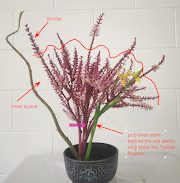Beyond Design Principles- Level 3.1. Line X Balance (17 September 2022)
Level 3 - Beyond Design Principles - Lines 3
When: (Melbourne, Australia Time) Check your local time.
2:00 - 2:30 PM (AEST), 17 Sept 2022
2:00 - 2:30 PM (AEST), 24 Sept 2022
2:00 - 2:30 PM (AEST), 1 Oct 2022
2:00 - 2:30 PM (AEDT), 29 Oct 2022 (Note: This session is AFTER the Australian Eastern Daylight Time (AEDT) has commenced on 2 Oct 2022)
How Many Participants: Up to 6 for each session
How Much: Aus $60 to join the program of 4 sessions.
Outline
Line: Line is one of the design elements. Design elements include point, line, texture, shape, mass and volume, space, colour, value, time, words, and sound.
In Ikebana, Line is one of the four major elements. Line usually means a series of connected points that make a length that seems to move in a direction. In addition to actual line, implied line can be used in Ikebana. We can perceive the line where areas of contrasting colour of texture meet.
Various branches, vines or stems are often used as line elements in Ikebana. They usually have a visible beginning and an end, but some lines have no apparent beginning or end.
In working with lines, you would need to consider their types: straight lines, curved lines, or combined or multiple lines. You would need not just to discover lines in natural materials but also need to create lines.
Each line element has its own “story”, “life” or “poetry” - soft, delicate, strong, bold, clean etc. Appreciate and meditate on it and develop it into an Ikebana work.
Always remember that you are aiming to go beyond designing an Ikebana work in this course. Rather than thinking analytically, try to train your intuition through “talking to” your materials. Your materials, not your brain, often tell you what to make.
In this session, 3.1. Line X Balance, please focus on straight line(s).
Balance: We have learned that in Ikebana visual balance is the equilibrium of weight and force in a work of art. We also learned that in Ikebana achieving an asymmetrical balance is crucial. Asymmetrical balance is visual or actual equilibrium of a composition not dependent on one side mirroring the other.
In Balance 1 we were encouraged to use an asymmetrical triangle as a guide. It is often an effective way to achieve asymmetrical balance in your work. In Balance 2 we mentioned a few other strategies to effectively achieve asymmetry.
In 3.1. Line X Balance your task is to start with finding lines in natural materials and create an arrangement emphasising asymmetrical balance. You would need to consider all other Ikebana principles as well.
Our video analyses a couple of sample works. We hope that will be a starting point for your creative meditation.
Objectives in Line x Balance
- Find various lines in natural materials. You can also create lines.
- Regard lines as “the bricks of a building”.
- Asymmetrical balance is the means by which you put elements (lines) together to construct a building.
- See the video for some samples and learn some strategies. It shows you how to meditate on natural materials. Rather than copying the sample work, try to learn the meditative process.
- Check your work in terms of other design principles, i.e., movement, contrast and pattern. You may not be able to apply all the principles, but trying to incorporate some of them may help improve your work.
- Meditate on your work with your selfless mind, without thinking about designs. Make adjustments.
- In some Ikebana workshops, you may hear comments such as "you failed because you did not show lines well." That is not our approach. We value design but we aim to go beyond design. In our Level 3 our goal is to achieve harmony which is higher than design in our definition.
What You Need
1. Secateurs
2. Container - any type.
3. Flower materials - as you like.
How to Make It?
After joining our program, you will receive our video which will help you analyse sample works, and help you make your Ikebana work.
What's Next? - Get Feedback
1. Check our course outline. Please note that Ikebana Dojo Level 3: Beyond Design Principles is not a normal online course and is specifically for advanced students of ikebana.
2. Book to join Zoom Ikebana Dojo by deadline. That is the first step. Follow the instruction on the page.
Please note that there are prerequisites to join Level 3.
a. If you have completed our Level 1 & 2, simply book from our booking page.
b. If you have not completed our Level 1 & 2, send (ikebana.dojo@gmail.com) 2 images of your recent works, one basic style and one freestyle (0.5 Meg or less). Once accepted, please book.
3. After receiving confirmation of your booking, we send you links to access our video tutorial & our Zoom session.
4. Join Zoom Ikebana Dojo. Enjoy friendly feedback from our facilitator and other participants.
5. Post your work to Ikebana Gallery Award.
References
Zoom Ikebana Dojo Level 3 Course OutlineShimbo, S. (2021). Ikebana: Flower Arrangement in Search of Poetry, Garland Magazine.






















